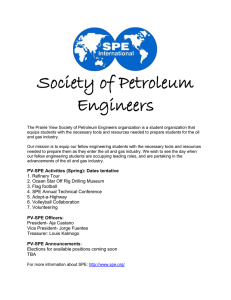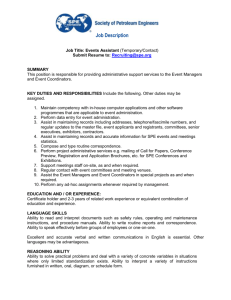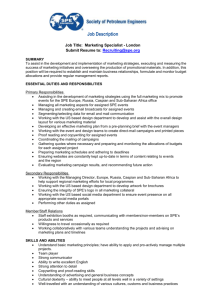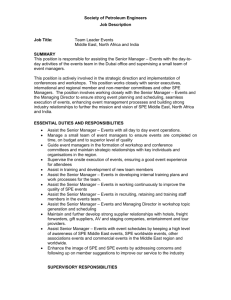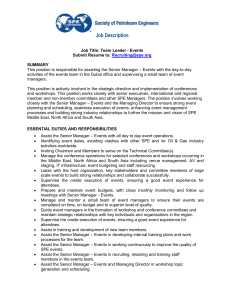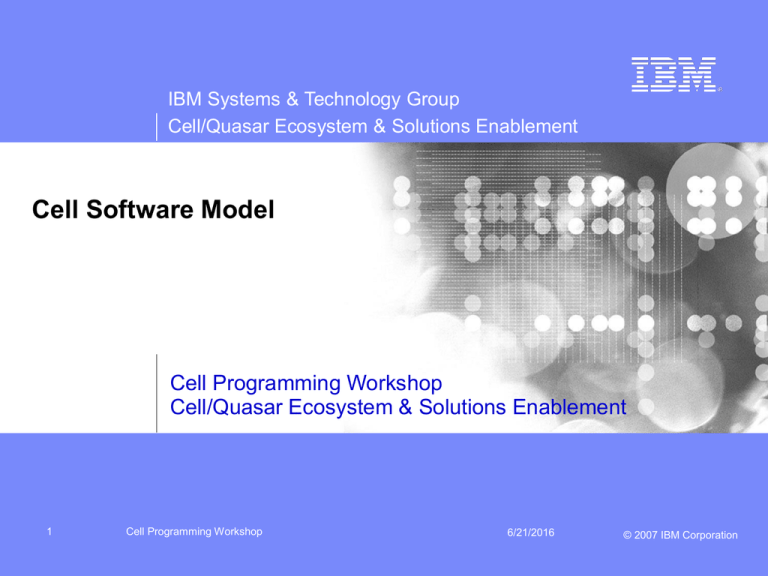
IBM Systems & Technology Group
Cell/Quasar Ecosystem & Solutions Enablement
Cell Software Model
Cell Programming Workshop
Cell/Quasar Ecosystem & Solutions Enablement
1
Cell Programming Workshop
6/21/2016
© 2007 IBM Corporation
IBM Systems & Technology Group – Cell/Quasar Ecosystem & Solutions Enablement
Class Objectives – Things you will learn
Programming models that exploit cell features
2
Cell Programming Workshop
6/21/2016
© 2007 IBM Corporation
IBM Systems & Technology Group – Cell/Quasar Ecosystem & Solutions Enablement
Class Agenda
Cell Programming Model Overview
PPE Programming Models
SPE Programming Models
Parallel Programming Models
Multi-tasking SPEs
Cell Software Development Flow
References
Michael Day, Ted Maeurer, and Alex Chow, Cell Software Overview
Trademarks - Cell Broadband Engine and Cell Broadband Engine Architecture are trademarks of Sony
Computer Entertainment, Inc.
3
Cell Programming Workshop
6/21/2016
© 2007 IBM Corporation
IBM Systems & Technology Group – Cell/Quasar Ecosystem & Solutions Enablement
The role of Cell programming models
Cell provides a massive computational capacity.
Cell provides a huge communicational bandwidth.
The resources are distributed.
A properly selected Cell programming model provides a programmer a systematic and
cost-effective framework to apply Cell resources to a particular class of applications.
A Cell programming model may be supported by language constructs, runtime, libraries,
or object-oriented frameworks.
4
Cell Programming Workshop
6/21/2016
© 2007 IBM Corporation
IBM Systems & Technology Group – Cell/Quasar Ecosystem & Solutions Enablement
Cell programming models
Single Cell environment:
Effective Address
Space
PPE programming models
Large
SPE Programming models
SPE LS
small
– Small single-SPE models
– Large single-SPE models
– Multi-SPE parallel programming
models
PPE thread
Cell Embedded SPE Object
Format (CESOF)
Multi-SPE
BE-level
SPE LS
5
Cell Programming Workshop
6/21/2016
© 2007 IBM Corporation
IBM Systems & Technology Group – Cell/Quasar Ecosystem & Solutions Enablement
Cell programming models - continued
Multi-tasking SPEs
– Local Store resident multi-tasking
– Self-managed multi-tasking
– Kernel-managed SPE scheduling and virtualization
Final programming model points
6
Cell Programming Workshop
6/21/2016
© 2007 IBM Corporation
IBM Systems & Technology Group – Cell/Quasar Ecosystem & Solutions Enablement
PPE Programming Model
7
Cell Programming Workshop
6/21/2016
© 2007 IBM Corporation
IBM Systems & Technology Group – Cell/Quasar Ecosystem & Solutions Enablement
PPE programming model (participation)
PPE is a 64-bit PowerPC core, hosting operating systems and hypervisor
PPE program inherits traditional programming models
Cell environment: a PPE program serves as a controller or facilitator
– CESOF support provides SPE image handles to the PPE runtime
– PPE program establishes a runtime environment for SPE programs
• e.g. memory mapping, exception handling, SPE run control
– It allocates and manages Cell system resources
• SPE scheduling, hypervisor CBEA resource management
– It provides OS services to SPE programs and threads
• e.g. printf, file I/O
8
Cell Programming Workshop
6/21/2016
© 2007 IBM Corporation
IBM Systems & Technology Group – Cell/Quasar Ecosystem & Solutions Enablement
Single SPE Programming Model
9
Cell Programming Workshop
6/21/2016
© 2007 IBM Corporation
IBM Systems & Technology Group – Cell/Quasar Ecosystem & Solutions Enablement
Small single-SPE models
Single tasked environment
Small enough to fit into a 256KB- local store
Sufficient for many dedicated workloads
Separated SPE and PPE address spaces – LS / EA
Explicit input and output of the SPE program
– Program arguments and exit code per SPE ABI
– DMA
– Mailboxes
– SPE side system calls
Foundation for a function offload model or a synchronous RPC model
– Facilitated by interface description language (IDL)
10
Cell Programming Workshop
6/21/2016
© 2007 IBM Corporation
IBM Systems & Technology Group – Cell/Quasar Ecosystem & Solutions Enablement
Small single-SPE models – tools and environment
SPE compiler/linker compiles and links an SPE executable
The SPE executable image is embedded as reference-able RO data in the PPE
executable (CESOF)
A Cell programmer controls an SPE program via a PPE controlling process and
its SPE management library
– i.e. loads, initializes, starts/stops an SPE program
The PPE controlling process, OS/PPE, and runtime/(PPE or SPE) together
establish the SPE runtime environment, e.g. argument passing, memory
mapping, system call service.
11
Cell Programming Workshop
6/21/2016
© 2007 IBM Corporation
IBM Systems & Technology Group – Cell/Quasar Ecosystem & Solutions Enablement
Small single-SPE models – a sample
/* spe_foo.c: A C program to be compiled into an executable called “spe_foo” */
int main( int speid, addr64 argp, addr64 envp)
{
char i;
/* do something intelligent here */
i = func_foo (argp);
/* when the syscall is supported */
printf( “Hello world! my result is %d \n”, i);
return i;
}
12
Cell Programming Workshop
6/21/2016
© 2007 IBM Corporation
IBM Systems & Technology Group – Cell/Quasar Ecosystem & Solutions Enablement
Small single-SPE models – PPE controlling program
extern spe_program_handle spe_foo; /* the spe image handle from CESOF */
int main()
{
int rc, status;
speid_t spe_id;
/* load & start the spe_foo program on an allocated spe */
spe_id = spe_create_thread (0, &spe_foo, 0, NULL, -1, 0);
/* wait for spe prog. to complete and return final status */
rc = spe_wait (spe_id, &status, 0);
return status;
}
13
Cell Programming Workshop
6/21/2016
© 2007 IBM Corporation
IBM Systems & Technology Group – Cell/Quasar Ecosystem & Solutions Enablement
Large single-SPE programming models
PPE controller
maps system
memory for
SPE DMA trans.
Data or code working set cannot fit
completely into a local store
The PPE controlling process, kernel,
and libspe runtime set up the system
memory mapping as SPE’s secondary
memory store
The SPE program accesses the
secondary memory store via its
software-controlled SPE DMA engine Memory Flow Controller (MFC)
SPE
Program
DMA
transactions
Local Store
System Memory
14
Cell Programming Workshop
6/21/2016
© 2007 IBM Corporation
IBM Systems & Technology Group – Cell/Quasar Ecosystem & Solutions Enablement
Large single-SPE programming models – I/O data
System memory for large size input / output data
– e.g. Streaming model
System memory
Local store
DMA
int g_ip[512*1024]
int ip[32]
SPE program: op = func(ip)
DMA
int op[32]
15
Cell Programming Workshop
int g_op[512*1024]
6/21/2016
© 2007 IBM Corporation
IBM Systems & Technology Group – Cell/Quasar Ecosystem & Solutions Enablement
Large single-SPE programming models
System memory as secondary memory store
– Manual management of data buffers
– Automatic software-managed data cache
• Software cache framework libraries
• Compiler runtime support
System memory
Local store
SW cache entries
SPE program
16
Cell Programming Workshop
Global objects
6/21/2016
© 2007 IBM Corporation
IBM Systems & Technology Group – Cell/Quasar Ecosystem & Solutions Enablement
Software Cache
Low Level API
Depend on cache type
Gives programmer direct
control
#include <spe_cache.h>
unsigned int __spe_cache_rd(unsigned int ea) {
unsigned int ea_aligned = (ea) & ~SPE_CACHELINE_MASK;
int set, line, byte, missing;
unsigned int ret;
– Look up
missing = _spe_cache_dmap_lookup_(ea_aligned, set);
line = _spe_cacheline_num_(set);
byte = _spe_cacheline_byte_offset_(ea);
ret = *((unsigned int *) &spe_cache_mem[line + byte]);
if (unlikely(missing)) {
_spe_cache_miss_(ea_aligned, set, 0, 1);
spu_writech(22, SPE_CACHE_SET_TAGMASK(set));
spu_mfcstat(MFC_TAG_UPDATE_ALL);
ret = *((unsigned int *) &spe_cache_mem[line + byte]);
}
return ret;
– Branch to miss handler
– Wait for DMA completion
Custom interfaces
– Multiple lookups
– Special data types
– Cache locking
17
Cell Programming Workshop
}
6/21/2016
© 2007 IBM Corporation
IBM Systems & Technology Group – Cell/Quasar Ecosystem & Solutions Enablement
High Level API’s
Common Operations
– Cached data read, write
– Pre-touch
– Flush
#include <spe_cache.h>
#define LOAD1(addr)
* ((char *) spe_cache_rd(addr))
\
#define STORE1(addr, c)
\
* ((char *) spe_cache_wr(addr)) = c
– Invalidate
– etc.
void memcpy_ea(uint dst, uint src, uint size)
{
Simplify programming
while (size > 0) {
char c = LOAD1(src);
STORE1(dst, c);
size--;
src++;
dst++;
– Hide details of DMA
}
}
18
Cell Programming Workshop
6/21/2016
© 2007 IBM Corporation
IBM Systems & Technology Group – Cell/Quasar Ecosystem & Solutions Enablement
Large single-SPE programming models
An overlay is SPU code
that is dynamically
loaded and executed by
a running SPU
program. It cannot be
independently loaded
or run on an SPE
System memory as secondary memory store
– Manual loading of plug-in into code buffer
• Plug-in framework libraries
– Automatic and manual software-managed code overlay
• Compiler and Linker generated overlaying code
System memory
SPE func a
Local store
Overlay
region 2
Overlay
region 1
Non-overlay
region
SPE func b
SPE func c
SPE func b or c
Call
Call
SPE func d
SPE func a, d or e
SPE func e
SPE func main & f
SPE func f
SPE func main
19
Cell Programming Workshop
6/21/2016
© 2007 IBM Corporation
IBM Systems & Technology Group – Cell/Quasar Ecosystem & Solutions Enablement
Large single-SPE programming models
Compile files without change
Link with linker script specifying manual overlay
structure. Anything not specified is in the nonoverlay region
OVERLAY : {
Source file(s)
Overlay
.segment1 {a.o(.text)}
region 1
.c file(s)
.segment2 {d.o(.text)}
SPU Compiler
.segment2 {e.o(.text)}
Overlay
.o file(s)
}
region 2
OVERLAY : {
SPU Linker
Linker script
.segment1 {b.o(.text)}
executable
.segment2 {c.o(.text)}
Executable
}
w/ overlays
overlay manager
Linker automatically includes overlay manager
and call stubs to invoke it
You can optionally provide your own overlay
manager.
20
Cell Programming Workshop
6/21/2016
© 2007 IBM Corporation
IBM Systems & Technology Group – Cell/Quasar Ecosystem & Solutions Enablement
Large single-SPE programming models – Job Queue
Code and data packaged together as inputs to
an SPE kernel program
System memory
A multi-tasking model
– more discussion later
code/data …
Local store
Job queue
Code n
Data n
DMA
code/data n
code/data n+1
code/data n+2
SPE kernel
21
Cell Programming Workshop
6/21/2016
© 2007 IBM Corporation
IBM Systems & Technology Group – Cell/Quasar Ecosystem & Solutions Enablement
Large single-SPE programming models - DMA
DMA latency handling is critical to overall performance for SPE programs
moving large data or code
Data pre-fetching is a key technique to hide DMA latency
– e.g. double-buffering
I Buf 1 (n)
O Buf 1 (n)
SPE exec.
SPE program: Func (n)
DMAs
DMAs
SPE exec.
outputn-2
inputn
Func (inputn-1)
I Buf 2 (n+1)
Outputn-1
Inputn+1
Func (inputn)
O Buf 2 (n-1)
outputn
Inputn+2
Func (inputn+1)
Time
22
Cell Programming Workshop
6/21/2016
© 2007 IBM Corporation
IBM Systems & Technology Group – Cell/Quasar Ecosystem & Solutions Enablement
Large single-SPE programming models - CESOF
Cell Embedded SPE Object Format (CESOF) and PPE/SPE toolchains support
the resolution of SPE references to the global system memory objects in the
effective-address space.
Effective Address Space
Local Store Space
_EAR_g_foo structure
Char local_foo[512]
23
Cell Programming Workshop
CESOF EAR
symbol resolution
DMA
transactions
Char g_foo[512]
6/21/2016
© 2007 IBM Corporation
IBM Systems & Technology Group – Cell/Quasar Ecosystem & Solutions Enablement
Parallel programming models
24
Cell Programming Workshop
6/21/2016
© 2007 IBM Corporation
IBM Systems & Technology Group – Cell/Quasar Ecosystem & Solutions Enablement
Parallel programming models
Traditional parallel programming models applicable
Based on interacting single-SPE programs
Parallel SPE program synchronization mechanism
•
•
•
•
•
25
Cache line-based MFC atomic update commands
SPE input and output mailboxes with PPE
SPE signal notification / register
SPE events and interrupts
SPE busy poll of shared memory location
Cell Programming Workshop
6/21/2016
© 2007 IBM Corporation
IBM Systems & Technology Group – Cell/Quasar Ecosystem & Solutions Enablement
Parallel programming models – Shared Memory
CBE can be programmed as a shared-memory multiprocessor
– PPE and SPE have different instruction sets and compilers
Access data by address
– Random access in nature
CESOF support for shared effective-address variables
With proper locking mechanism, large SPE programs may access shared
memory objects located in the effective-address space
Compiler OpenMP support
26
Cell Programming Workshop
6/21/2016
© 2007 IBM Corporation
IBM Systems & Technology Group – Cell/Quasar Ecosystem & Solutions Enablement
Parallel programming models – Shared Memory
SPEs and the PPE fully inter-operate in a cache-coherent model
Cache-coherent DMA operations for SPEs
– DMA operations use effective address common to all PPE and SPEs
– SPE shared-memory store instructions are replaced
• A store from the register file to the LS
• DMA operation from LS to shared memory
– SPE shared-memory load instructions are replaced
• DMA operation from shared memory to LS
• A load from LS to register file
A compiler could manage part of the LS as a local cache for instructions
and data obtained from shared memory.
27
Cell Programming Workshop
6/21/2016
© 2007 IBM Corporation
IBM Systems & Technology Group – Cell/Quasar Ecosystem & Solutions Enablement
Parallel programming models – Message Passing
Access data by connection
– Sequential in nature
Applicable to SPE programs where addressable data space only spans over
local store
The message connection is still built on top of the shared memory model
Compared with software-cache shared memory model
– More efficient runtime is possible, no address info handling overhead once
connected
– LS to LS DMA optimized for data streaming through pipeline model
28
Cell Programming Workshop
6/21/2016
© 2007 IBM Corporation
IBM Systems & Technology Group – Cell/Quasar Ecosystem & Solutions Enablement
Parallel programming models – Streaming
SPE initiated DMA
System Memory
Large array of data fed through a
group of SPE programs
I0
O0
I1
O1
A special case of job queue with
regular data
I2
O2
I3
O3
I4
O4
I5
O5
I6
O6
I7
O7
.
.
In
On
Each SPE program locks on the
shared job queue to obtain next job
For uneven jobs, workloads are selfbalanced among available SPEs
PPE
Data-parallel
29
Cell Programming Workshop
SPE0
Kernel()
SPE1
Kernel()
6/21/2016
…..
SPE7
Kernel()
© 2007 IBM Corporation
IBM Systems & Technology Group – Cell/Quasar Ecosystem & Solutions Enablement
Parallel programming models – Pipeline
System Memory
I0
O0
I1
O1
I2
O2
I3
O3
Flexibility in connecting pipeline functions
I4
O4
I5
O5
Larger collective code size per pipeline
I6
O6
Load-balance is harder
.
.
.
.
In
On
Use LS to LS DMA bandwidth, not system
memory bandwidth
PPE
DMA
Task-parallel
30
Cell Programming Workshop
SPE0
Kernel0()
DMA
SPE1
Kernel1()
6/21/2016
…..
SPE7
Kernel7()
© 2007 IBM Corporation
IBM Systems & Technology Group – Cell/Quasar Ecosystem & Solutions Enablement
Multi-tasking SPEs Model
31
Cell Programming Workshop
6/21/2016
© 2007 IBM Corporation
IBM Systems & Technology Group – Cell/Quasar Ecosystem & Solutions Enablement
Multi-tasking SPEs – LS resident multi-tasking
Event Queue
Simplest multi-tasking programming model
No memory protection among tasks
Task a
Co-operative, Non-preemptive, eventdriven scheduling (FIFO run-to-completion
models, or lightweight cooperativelyyielding models)
Task b
A single SPE can run only
one thread at a time; it
cannot support multiple
simultaneous threads
Task c
Task d
Event
Dispatcher
a
c
a
d
x
a
c
d
Task x
Local Store
SPE n
32
Cell Programming Workshop
6/21/2016
© 2007 IBM Corporation
IBM Systems & Technology Group – Cell/Quasar Ecosystem & Solutions Enablement
Multi-tasking SPEs – Self-managed multi-tasking
Non-LS resident
System memory
Blocked job context is swapped out of LS and scheduled
back later to the job queue once unblocked
task queue
Task …
Local store
Job queue
Code n
task n
Data n
task n+1
task n+2
SPE kernel
33
Cell Programming Workshop
task n’
6/21/2016
© 2007 IBM Corporation
IBM Systems & Technology Group – Cell/Quasar Ecosystem & Solutions Enablement
Multi-tasking SPEs – Kernel managed
Kernel-level SPE management model
– SPE as a device resource
– SPE as a heterogeneous processor
– SPE resource represented as a file system
SPE scheduling and virtualization
– Maps running threads over a physical SPE or a group of SPEs
– More concurrent logical SPE tasks than the number of physical SPEs
– High context save/restore overhead
• favors run-to-completion scheduling policy
– Supports pre-emptive scheduling when needed
– Supports memory protection
34
Cell Programming Workshop
6/21/2016
© 2007 IBM Corporation
IBM Systems & Technology Group – Cell/Quasar Ecosystem & Solutions Enablement
Programming Model Final Points
A proper programming model reduces development cost while achieving higher
performance
Programming frameworks and abstractions help with productivity
Mixing programming models are common practice
New models may be developed for particular applications.
With the vast computational capacity, it is not hard to achieve a performance gain
from an existing legacy base
Top performance is harder
Tools are critical in improving programmer productivity
35
Cell Programming Workshop
6/21/2016
© 2007 IBM Corporation
IBM Systems & Technology Group – Cell/Quasar Ecosystem & Solutions Enablement
Special Notices -- Trademarks
This document was developed for IBM offerings in the United States as of the date of publication. IBM may not make these offerings available in
other countries, and the information is subject to change without notice. Consult your local IBM business contact for information on the IBM
offerings available in your area. In no event will IBM be liable for damages arising directly or indirectly from any use of the information contained
in this document.
Information in this document concerning non-IBM products was obtained from the suppliers of these products or other public sources. Questions
on the capabilities of non-IBM products should be addressed to the suppliers of those products.
IBM may have patents or pending patent applications covering subject matter in this document. The furnishing of this document does not give
you any license to these patents. Send license inquires, in writing, to IBM Director of Licensing, IBM Corporation, New Castle Drive, Armonk, NY
10504-1785 USA.
All statements regarding IBM future direction and intent are subject to change or withdrawal without notice, and represent goals and objectives
only.
The information contained in this document has not been submitted to any formal IBM test and is provided "AS IS" with no warranties or
guarantees either expressed or implied.
All examples cited or described in this document are presented as illustrations of the manner in which some IBM products can be used and the
results that may be achieved. Actual environmental costs and performance characteristics will vary depending on individual client configurations
and conditions.
IBM Global Financing offerings are provided through IBM Credit Corporation in the United States and other IBM subsidiaries and divisions
worldwide to qualified commercial and government clients. Rates are based on a client's credit rating, financing terms, offering type, equipment
type and options, and may vary by country. Other restrictions may apply. Rates and offerings are subject to change, extension or withdrawal
without notice.
IBM is not responsible for printing errors in this document that result in pricing or information inaccuracies.
All prices shown are IBM's United States suggested list prices and are subject to change without notice; reseller prices may vary.
IBM hardware products are manufactured from new parts, or new and serviceable used parts. Regardless, our warranty terms apply.
Many of the features described in this document are operating system dependent and may not be available on Linux. For more information,
please check: http://www.ibm.com/systems/p/software/whitepapers/linux_overview.html
Any performance data contained in this document was determined in a controlled environment. Actual results may vary significantly and are
dependent on many factors including system hardware configuration and software design and configuration. Some measurements quoted in this
document may have been made on development-level systems. There is no guarantee these measurements will be the same on generallyavailable systems. Some measurements quoted in this document may have been estimated through extrapolation. Users of this document
should verify the applicable data for their specific environment.
Revised January 19, 2006
36
Cell Programming Workshop
6/21/2016
© 2007 IBM Corporation
IBM Systems & Technology Group – Cell/Quasar Ecosystem & Solutions Enablement
Special Notices (Cont.) -- Trademarks
The following terms are trademarks of International Business Machines Corporation in the United States and/or other countries: alphaWorks, BladeCenter,
Blue Gene, ClusterProven, developerWorks, e business(logo), e(logo)business, e(logo)server, IBM, IBM(logo), ibm.com, IBM Business Partner (logo),
IntelliStation, MediaStreamer, Micro Channel, NUMA-Q, PartnerWorld, PowerPC, PowerPC(logo), pSeries, TotalStorage, xSeries; Advanced MicroPartitioning, eServer, Micro-Partitioning, NUMACenter, On Demand Business logo, OpenPower, POWER, Power Architecture, Power Everywhere, Power
Family, Power PC, PowerPC Architecture, POWER5, POWER5+, POWER6, POWER6+, Redbooks, System p, System p5, System Storage, VideoCharger,
Virtualization Engine.
A full list of U.S. trademarks owned by IBM may be found at: http://www.ibm.com/legal/copytrade.shtml.
Cell Broadband Engine and Cell Broadband Engine Architecture are trademarks of Sony Computer Entertainment, Inc. in the United States, other countries,
or both.
Rambus is a registered trademark of Rambus, Inc.
XDR and FlexIO are trademarks of Rambus, Inc.
UNIX is a registered trademark in the United States, other countries or both.
Linux is a trademark of Linus Torvalds in the United States, other countries or both.
Fedora is a trademark of Redhat, Inc.
Microsoft, Windows, Windows NT and the Windows logo are trademarks of Microsoft Corporation in the United States, other countries or both.
Intel, Intel Xeon, Itanium and Pentium are trademarks or registered trademarks of Intel Corporation in the United States and/or other countries.
AMD Opteron is a trademark of Advanced Micro Devices, Inc.
Java and all Java-based trademarks and logos are trademarks of Sun Microsystems, Inc. in the United States and/or other countries.
TPC-C and TPC-H are trademarks of the Transaction Performance Processing Council (TPPC).
SPECint, SPECfp, SPECjbb, SPECweb, SPECjAppServer, SPEC OMP, SPECviewperf, SPECapc, SPEChpc, SPECjvm, SPECmail, SPECimap and
SPECsfs are trademarks of the Standard Performance Evaluation Corp (SPEC).
AltiVec is a trademark of Freescale Semiconductor, Inc.
PCI-X and PCI Express are registered trademarks of PCI SIG.
InfiniBand™ is a trademark the InfiniBand® Trade Association
Other company, product and service names may be trademarks or service marks of others.
Revised July 23, 2006
37
Cell Programming Workshop
6/21/2016
© 2007 IBM Corporation
IBM Systems & Technology Group – Cell/Quasar Ecosystem & Solutions Enablement
Special Notices - Copyrights
(c) Copyright International Business Machines Corporation 2005.
All Rights Reserved. Printed in the United Sates September 2005.
The following are trademarks of International Business Machines Corporation in the United States, or other countries, or both.
IBM
IBM Logo
Power Architecture
Other company, product and service names may be trademarks or service marks of others.
All information contained in this document is subject to change without notice. The products described in this document are
NOT intended for use in applications such as implantation, life support, or other hazardous uses where malfunction could result
in death, bodily injury, or catastrophic property damage. The information contained in this document does not affect or change
IBM product specifications or warranties. Nothing in this document shall operate as an express or implied license or indemnity
under the intellectual property rights of IBM or third parties. All information contained in this document was obtained in specific
environments, and is presented as an illustration. The results obtained in other operating environments may vary.
While the information contained herein is believed to be accurate, such information is preliminary, and should not be relied
upon for accuracy or completeness, and no representations or warranties of accuracy or completeness are made.
THE INFORMATION CONTAINED IN THIS DOCUMENT IS PROVIDED ON AN "AS IS" BASIS. In no event will IBM be liable
for damages arising directly or indirectly from any use of the information contained in this document.
IBM Microelectronics Division
1580 Route 52, Bldg. 504
Hopewell Junction, NY 12533-6351
38
Cell Programming Workshop
The IBM home page is http://www.ibm.com
The IBM Microelectronics Division home page is
http://www.chips.ibm.com
6/21/2016
© 2007 IBM Corporation


